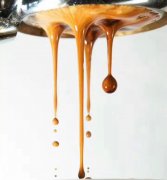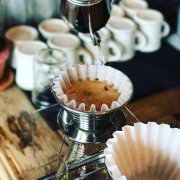Light roasted coffee is the embodiment of various flavors of fine coffee.
A brief discussion on the baking of coffee beans when high-quality coffee beans are picked, the most important step to make them into gourmet coffee is to bake and mix.
A master baker must have the temperament of an artist and the rigor of a scientist. Only in this way can we ensure that the sugars and other carbohydrates in the coffee are carbonized during the baking process, thus producing the well-known coffee fat and producing good coffee of high quality and consistent style. Academically, this subtle chemical is not really grease (because it is soluble in water), but it is the source of the aroma of coffee.
Professional coffee is generally roasted in small batches. The most common baking methods are drum baking and hot air baking. The drum roaster puts the coffee beans in a rotating vat and burns gas or wood to bake them. When the desired baking degree is reached, the coffee beans can be poured into a cooling funnel to prevent overbaking. A hot air roaster, also known as a fluidization air roaster, roasts coffee beans by rolling them in hot air. Most raw coffee beans are roasted at a temperature of nearly 400 degrees. During the baking process, the volume of coffee beans expands by more than 50%, while their weight decreases. The color of lightly roasted coffee beans is between cinnamon and light chocolate. Because it tastes sour, it is generally not used to make espresso. Deep baking, comparatively speaking, has a more bitter and sweet flavor. The aroma extracted from coffee beans is proportional to the baking time. The deeper the baking, the less caffeine and acidity. The color of deep-roasted coffee beans is between chocolate or oily brown and black. The deeper the baking, the more scorched you taste and the lighter the taste of the coffee bean itself. Especially deep-roasted coffee beans will have a smoky taste, which is more suitable for ordinary coffee than Italian coffee.
Many bakers use the following terms to describe different degrees of baking: cinnamon, medium baking, urban style, fully urban style, French style and Italian style. On the west coast of the United States, "French style" is often used to describe the deepest baking. You know, this term has nothing to do with the origin of coffee or the place where it is roasted.

Important Notice :
前街咖啡 FrontStreet Coffee has moved to new addredd:
FrontStreet Coffee Address: 315,Donghua East Road,GuangZhou
Tel:020 38364473
- Prev

Why doesn't my coffee taste the importance of the Italian bean grinder every day?
A perfect Espresso usually affects its taste and aroma expression due to changes in temperature. So, we have a debate about how to preheat the handle and the filter screen in the extraction of Espresso, but how much does the temperature of the handle and filter affect the Espresso? how much will the Espresso cool down? Here, I'm going to do a little test, hoping to know more about it.
- Next

Attentively make a cup of fine coffee from the most basic understanding of fine coffee
Coffee extraction principle the core process of coffee extraction principle: 1 crushing coffee beans to increase the surface area of coffee in contact with water; 2 coffee powder fully soaked in aqueous solution, coffee essence hydrophilic dissolution; 3 separation of coffee solution and coffee grounds. All modern coffee extraction is the two core processes of soaking and filtration, which belongs to the category of physics, and there is basically no chemical change in the process. Coffee powder
Related
- Beginners will see the "Coffee pull flower" guide!
- What is the difference between ice blog purified milk and ordinary milk coffee?
- Why is the Philippines the largest producer of crops in Liberia?
- For coffee extraction, should the fine powder be retained?
- How does extracted espresso fill pressed powder? How much strength does it take to press the powder?
- How to make jasmine cold extract coffee? Is the jasmine + latte good?
- Will this little toy really make the coffee taste better? How does Lily Drip affect coffee extraction?
- Will the action of slapping the filter cup also affect coffee extraction?
- What's the difference between powder-to-water ratio and powder-to-liquid ratio?
- What is the Ethiopian local species? What does it have to do with Heirloom native species?

